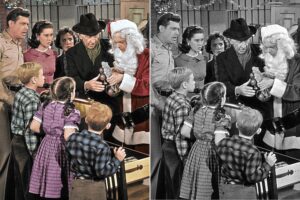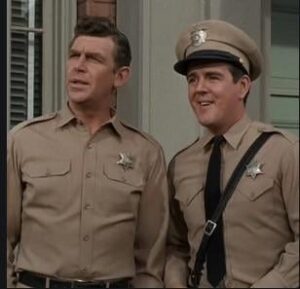
Introduction: The Andy Griffith Show’s Color Debate
When we think of The Andy Griffith Show, the first thing that often comes to mind is the quaint, small-town charm of Mayberry, brought to life through a lens of black-and-white television. However, did you know that some seasons of the beloved show were filmed in color? That’s right, the iconic series, which originally aired in black and white, made a bold leap into color during its run. But how many seasons of The Andy Griffith Show were filmed in color, and what impact did this transition have on the show’s legacy?
In this article, we’ll dive into the history behind the transition to color filming, the reasons behind it, and the lasting effects this shift had on the show’s storytelling and viewership. Let’s take a stroll through time and uncover how The Andy Griffith Show embraced color and why it matters in TV history.
The Shift from Black and White to Color: When Did It Happen?
The Early Years: A Black and White Classic
When The Andy Griffith Show premiered in 1960, it was typical for TV shows to be shot in black and white. The show captured the simplicity of rural life, with its straightforward plotlines, endearing characters, and heartwarming moments, all fitting perfectly within the limitations of black-and-white television. For the first few seasons, the absence of color didn’t seem to detract from its charm or success.
Why Did ‘The Andy Griffith Show’ Switch to Color?
By the mid-1960s, television technology had advanced significantly, and color television sets became more common in American homes. The shift from black and white to color was seen as a natural evolution in the entertainment industry. Networks began to push for color programming to attract viewers who had upgraded their TVs.
The Andy Griffith Show wasn’t immune to this shift. The decision to film in color was largely influenced by the changing landscape of television and the desire to keep up with the competition. Other popular TV shows like The Beverly Hillbillies and Bonanza had already embraced color, and it made sense for The Andy Griffith Show to follow suit to stay relevant.

Which Seasons Were Filmed in Color?
Seasons 6 to 8: The Golden Years of Color
The shift to color occurred relatively late in The Andy Griffith Show’s run. While the first five seasons of the show (1960-1965) were filmed in black and white, the show made its transition to color with the start of season 6 in 1965. This marked a major turning point for the series. Seasons 6, 7, and 8 were filmed in color, showcasing the vibrant backdrop of Mayberry in all its glory.
The inclusion of color brought new life to the show, with the iconic green hills of Mayberry and the pastel colors of Aunt Bee’s kitchen now fully visible to viewers. The move to color was not just a technical advancement but also symbolized a shift in the show’s evolving style and appeal.
Why Wasn’t the Entire Show Filmed in Color?
The Final Season: A Return to Simplicity
Although The Andy Griffith Show embraced color in seasons 6 to 8, the final season, season 9, saw a return to black and white. There were a couple of factors behind this decision. One of the main reasons was the departure of Don Knotts, who had played the beloved character of Deputy Barney Fife. Knotts left the show after season 6, and with his exit, the series lost some of its charm and audience appeal.
Additionally, the show’s move to black and white for the final season was in part due to a shift in TV viewership habits. By the time the show entered its final year, many shows had already adopted color, and The Andy Griffith Show was trying to capture that same nostalgic appeal. Some believed returning to black and white was a way to evoke the show’s earlier, simpler days, even though the impact was not as strong as it had been with the color seasons.
The Impact of Color on the Show’s Storytelling
Visual Storytelling: How Color Added Depth
Filming in color allowed The Andy Griffith Show to deepen its storytelling in subtle ways. For example, the colorful clothing and vibrant outdoor scenes added an extra layer of realism, bringing the fictional town of Mayberry to life in a way that black-and-white television could not. The richness of color helped accentuate the peaceful, idyllic life of Mayberry, making it a more visually appealing place for audiences to escape to each week.
Changes in Set Design and Wardrobe
With the advent of color, the show’s production team had to pay closer attention to set design, lighting, and wardrobe choices. What worked in black and white did not always translate to color, and a careful eye was needed to ensure that the show maintained its visual appeal. For example, Aunt Bee’s pastel-colored dresses and the vibrant green of the town’s trees became central elements of the show’s aesthetic.

Audience Reception: How Did Viewers Respond?
Mixed Reactions to the Color Seasons
While many viewers were thrilled to see the show in color, others were nostalgic for the simplicity of the earlier black-and-white years. The transition wasn’t universally loved, but it did help the show remain relevant and capture new audiences who were drawn to color TV.
The move to color also provided The Andy Griffith Show with an opportunity to experiment with new filming techniques and visual storytelling methods. This added richness to the show’s overall presentation, even if the impact wasn’t as dramatic as it had been for other shows at the time.
The Legacy of ‘The Andy Griffith Show’ in Color
A Show That Defined an Era
Even though The Andy Griffith Show only embraced color for three seasons, those years are fondly remembered by fans as some of the most iconic in TV history. The show’s ability to adapt to changing times while still retaining its heart and charm is one of the reasons it remains such a beloved classic today.
The Enduring Appeal of Mayberry
Today, the color episodes of The Andy Griffith Show continue to captivate audiences. The color seasons hold a special place in the hearts of fans who appreciate the full visual experience, from the colorful characters to the bright, sunny scenes that defined the show’s charm.
Conclusion: Color Seasons that Still Shine
In conclusion, The Andy Griffith Show transitioned to color in seasons 6, 7, and 8, embracing the new technology as TV audiences shifted toward color programming. The move added depth and richness to the show, while also allowing the production team to showcase Mayberry in a whole new light. While the decision to return to black and white for the final season may have been nostalgic, the color seasons stand as a testament to the show’s ability to evolve with the times.
Frequently Asked Questions (FAQs)
- When did ‘The Andy Griffith Show’ switch to color?
- The show transitioned to color with season 6 in 1965, after five seasons in black and white.
- Why did ‘The Andy Griffith Show’ return to black and white for its final season?
- The return to black and white in season 9 was a creative decision, partly due to the departure of Don Knotts and a desire to evoke the show’s earlier days.
- How many seasons of ‘The Andy Griffith Show’ were filmed in color?
- Three seasons (seasons 6, 7, and 8) were filmed in color.
- What impact did color have on ‘The Andy Griffith Show’?
- Color added depth to the visual storytelling, highlighting the vibrant outdoor scenes and the colorful characters of Mayberry.
-
Is it worth watching the color episodes of ‘The Andy Griffith Show’?
- Absolutely! The color seasons provide a fresh look at the show, enhancing the nostalgic experience with vivid visuals and more dynamic storytelling.
